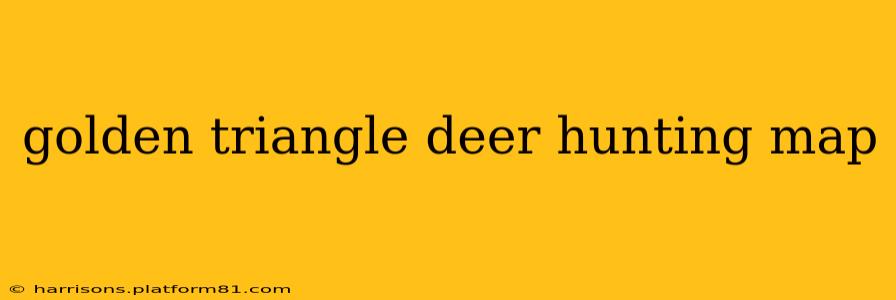The "Golden Triangle" – a term often whispered among seasoned deer hunters – refers to a prime hunting area, typically characterized by a convergence of ideal habitat features that attract and sustain a healthy deer population. However, there's no single, universally recognized "Golden Triangle." Its location varies drastically depending on the region and specific landscape features. This guide will help you identify and map your Golden Triangle, wherever it may be.
Identifying your Golden Triangle involves understanding the key elements deer need to thrive: food, water, and cover. Mapping these elements is crucial for successful hunting. Let's explore how:
What Makes Up a Deer's Ideal Habitat? (And How to Map It)
1. Food Sources: Deer are herbivores with diverse diets. Understanding their preferred food sources is essential. Common food sources include:
- Agricultural Fields: Corn, soybeans, alfalfa – map these fields clearly. Note their proximity to other crucial habitat elements.
- Hardwood Forests: Oaks, hickories, maples, and other mast-producing trees provide acorns and nuts. Identify these forests on your map and note the tree species prevalent within them.
- Browse: Deer consume various shrubs and young trees, like blackberry bushes, sumac, and dogwood. Include these areas on your map, noting their density and location.
2. Water Sources: Access to clean water is vital. Map these features meticulously:
- Streams and Rivers: Mark their exact location and flow direction on your map.
- Ponds and Lakes: Indicate their size and depth.
- Springs: These are often overlooked, yet crucial. Locate and map any springs within your hunting area.
3. Cover: Deer require safe havens for resting, bedding, and escaping predators. Identify these areas:
- Thickets and Brush: Dense vegetation provides excellent concealment. Map areas of thick brush and overgrown vegetation.
- Mature Forests: Large trees offer shade and protection. Outline areas of dense, mature forest on your map.
- Swamps and Marshes: These areas offer excellent cover, especially during inclement weather. Indicate these areas on your map, paying close attention to accessibility.
How to Create Your Own Golden Triangle Hunting Map
Several methods exist for creating your map:
- Traditional Paper Maps: Use topographic maps from sources like the USGS. Mark the food, water, and cover elements you identify.
- GPS Mapping Apps: Use apps like OnX Hunt, Gaia GPS, or Google Earth to create digital maps. These apps allow for precise marking and layering of information.
- Satellite Imagery: Utilize satellite imagery to better visualize the landscape. Combine this with ground scouting for the most accurate mapping.
Remember, layering your map is key. Overlaying food sources, water sources, and cover areas will reveal the most attractive areas to deer. The intersection of these elements creates your hunting area’s Golden Triangle.
Frequently Asked Questions (FAQ)
What is the best time of year to map my Golden Triangle?
The best time is during the late summer or early fall. The vegetation is still relatively visible, allowing easier identification of food and cover sources.
How much area should my Golden Triangle encompass?
The size depends on your hunting area. Focus on a manageable area where you can effectively scout and hunt.
Can I use Google Maps for creating my hunting map?
While Google Maps can provide a general overview, it lacks the detail necessary for effective hunting map creation. Topographic maps and specialized hunting apps are far more suitable.
What if there is no clear convergence of food, water, and cover?
In such cases, focus on areas where two of the three elements are present in close proximity. Deer will still frequent these locations.
By meticulously mapping your hunting area and understanding the factors that attract deer, you'll significantly increase your chances of success. Remember, patience, persistence, and a well-planned approach are crucial for unlocking the secrets of your personal Golden Triangle.
